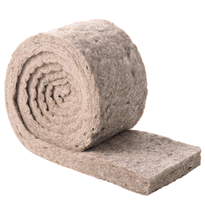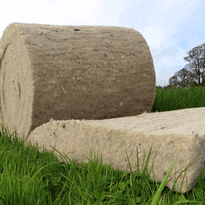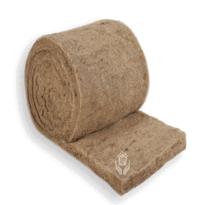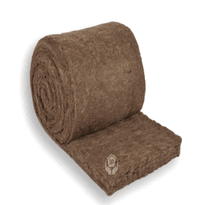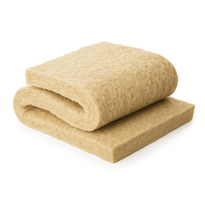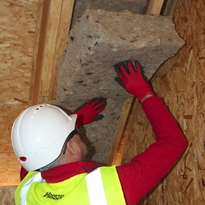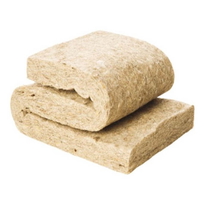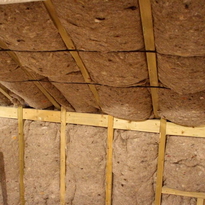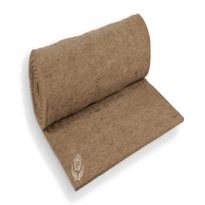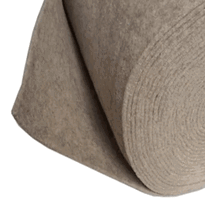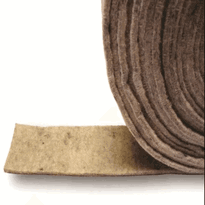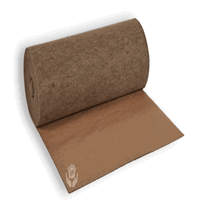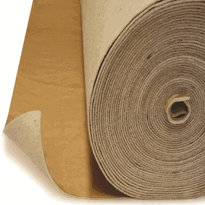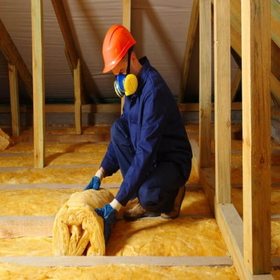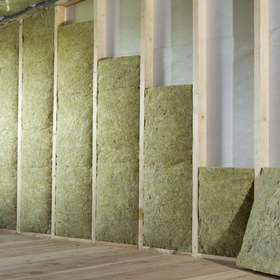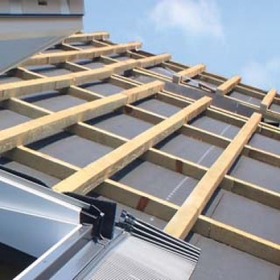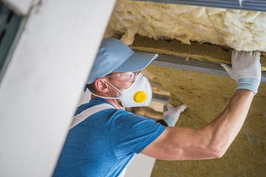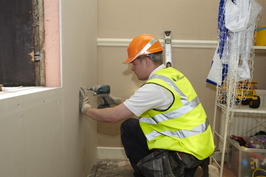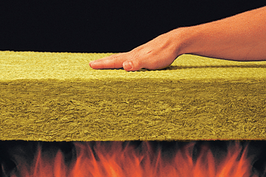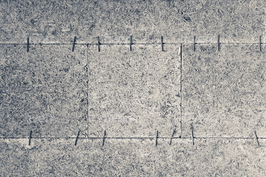SheepWool Insulation
Similar Categories
Sheepwool Insulation: Keep Your Home Cosy With Sheep Wool Insulation
When it comes to insulating our homes, offices, and other structures, we often seek a solution that not only keeps us warm but also aligns with our environmental values. Sheep's wool is an eco-friendly and sustainable material that can keep your home cosy and comfortable all year. Sheepwool insulation offers an ingenious blend of natural warmth, durability, and eco-friendliness, making it an increasingly popular choice among homeowners and construction professionals alike.
This material when concealed beneath floors, above ceilings and behind walls, helps control the interior temperature, reduces noise, improves indoor air quality and saves energy. This article will unravel its unique properties, explore its sustainable origins, and highlight the numerous advantages it brings to the table.
Whether you're a curious homeowner seeking to improve your living space or a sustainability enthusiast interested in eco-conscious building materials, this article is for you.
What is Sheepwool Insulation?
As its name indicates, sheep wool insulation is manufactured from the natural fibres of sheep's wool. It is a natural and renewable resource that has been used for centuries to provide warmth and comfort in various applications, including building insulation.
How is sheep wool insulation made?![sheep]()
Sheep wool insulation is made through a series of processes that transform raw sheep's wool into a usable insulation material. Here is an overview of the typical manufacturing process:
1. Shearing: Sheep are sheared to remove their wool, which is usually done once a year during the springtime. Shearing is a necessary practice to keep the sheep healthy and comfortable.
2. Sorting and Cleaning: The sheared wool is then sorted to remove any impurities such as dirt, twigs, or coarse fibres. This process ensures that only high-quality wool is used for insulation production. The wool is also thoroughly cleaned to remove any remaining impurities or oils. The sorted and cleaned wool is then carded, by passing it through a machine with fine-toothed rollers to align the wool fibres and remove any remaining debris or tangles.
3. Treatment: To enhance the insulation properties and durability of the wool, it may undergo certain treatments. The most common treatment is the application of a natural borax-based solution, which acts as a fire retardant and insect repellent. Other treatments may include anti-fungal or anti-microbial agents like ionic protect, depending on the manufacturer's specifications.
4. Formation: The treated wool fibres are then formed into batts, rolls, or loose-fill forms, depending on the intended application. Batts and rolls are commonly used for insulating walls, roofs, between ceiling joists or lofts and floors, while loose-fill wool is often used for cavity or attic insulation. Some manufacturers make 100% pure sheep wool insulation while some others use only 75% sheep wool and ~25% polyester or recycled fibres, depending on the desired end product and properties.
Why is Sheep wool a popular choice for insulation in the UK?
For several convincing reasons, sheep wool insulation is a common choice for insulation material in the UK. First, sheep wool has outstanding thermal properties that enable it to retain heat and keep dwellings warm in the winter efficiently. This is especially helpful given the environment in the UK, where cooler temperatures are typical.
One of the remarkable qualities of this natural insulation is its ability to absorb and release moisture. It can absorb up to 30% of its weight in water vapour without losing its insulating properties. This moisture regulation feature helps maintain a healthy and comfortable indoor environment by preventing the buildup of condensation, which can lead to mould growth and poor air quality.
Additionally, sheep wool fibre insulation is naturally fire-resistant and does not release toxic gases when exposed to flames. This fire-retardant characteristic makes it a safe choice for insulation, providing added peace of mind to homeowners and occupants.
The sustainability of sheep wool insulation is another important consideration. It is a renewable and biodegradable resource, and the UK highly values environmental stewardship. It is an environmentally beneficial option for insulation because it is a natural byproduct of the sheep farming business.
Furthermore, it has great sound-absorbing capabilities that lower noise transmission and improve building acoustic comfort. This is especially beneficial for metropolitan locations, houses near busy roads, or residences in loud situations.
Finally, It is safe and simple to handle because it doesn't require protective equipment during installation. It is a healthier solution for installers and tenants because it lacks hazardous chemicals and allergens. Combining all these benefits makes it a popular and preferred choice in the UK.
Thermal Performance And Moisture Regulation
 Most UK homeowners prefer installing sheep's wool insulation compared to fibreglass, thanks to its thermal properties. Unlike other materials, its thermal conductivity is fairly good. Its qualities make it useful for ensuring comfort and energy efficiency in dwellings, hence minimising heating bills.
Most UK homeowners prefer installing sheep's wool insulation compared to fibreglass, thanks to its thermal properties. Unlike other materials, its thermal conductivity is fairly good. Its qualities make it useful for ensuring comfort and energy efficiency in dwellings, hence minimising heating bills.
Sheep wool fibres have a natural crimped structure that creates tiny air pockets within thier fabric. These air pockets act as insulating barriers by slowing down the transfer of heat. Air is a poor conductor of heat, so the trapped air within the wool fibres helps to minimise heat flow, reducing heat loss in cold weather and heat gain in warm weather.
The most distinct benefit of lambs wool insulation is its breathability. The wool insulation fibres can absorb and release moisture from the environment without affecting its ability to retain heat effectively. Furthermore, the wool is hygroscopic. They can absorb up to 35% of their weight from the surrounding atmosphere, depending on thier manufacturing process. This helps to preserve the surrounding timbers.
This unique feature is essential for preserving a healthy indoors since too much moisture can result in mould formation and reduced insulating effectiveness. Sheep wool's capacity to control moisture aids in avoiding condensation and related problems.
A greater R-value for sheep wool insulation results from combining these thermal characteristics. Since sheeps wool insulation often has a greater R-value than other types of insulation like fibreglass or cellulose, it is a great option for maximising energy efficiency. Therefore, its mighty thermal properties make it worth your investment as wall insulation.
Sound Absorption and Acoustic Benefits
Sometimes, in addition to thermal properties, people also seek acoustic comfort from insulation products. Sheep's wool insulation perfectly fits this criteria.
Thanks to its fibrous structure, sheeps wool helps to create a quieter and more comfortable acoustic environment. When sound waves travel through the air, they encounter the dense wool fibres, which disrupt and scatter the sound energy. The irregular shape and texture of the fibres create multiple surfaces for sound waves to interact with, resulting in sound energy being converted into heat energy through friction.
The presence of numerous layers of wool fibres significantly decreases the transmission of sound through the air. It can dampen and absorb sound waves, stopping them from bouncing off solid objects and lowering echo and reverberation in a room. Wool fibre's ability to absorb and disperse sound energy helps to minimise noise transmission between spaces or outside sources. A calmer and more tranquil living or working environment might result since it can increase seclusion and lessen interruptions from outside noises.
Environmental Sustainability
Most countries aim to protect their environment; the UK is no exception. Thus, most citizens are advised to go for eco-friendly insulation. Sheep wool insulation is natural and sustainable with numerous advantages for the environment.
First of all, sheep wool is a resource that can be replenished. It is a natural and renewable fibre because it is a byproduct of sheep farming. Sheep are sheared yearly, and their wool grows back, providing them with a renewable and continual source of insulating material.
Sheepskin is also biodegradable. Sheep wool insulation may decompose spontaneously at the end of its lifespan without harming the environment. In contrast, synthetic insulating materials can take a long time to disintegrate and may cause waste to accumulate.
Furthermore, the carbon impact of wool is quite small. Compared to the energy-intensive production of synthetic materials, it uses very little energy throughout the production process. Sheep wool has a great capacity to sequester carbon, too. Healthy grasslands absorb carbon dioxide from the atmosphere due to sheep grazing on pastures.
Thus, from the above, we can all concur that sheepwool promotes the environment's well-being. Choosing it can align with eco-conscious building practices, helping to reduce the environmental impact of construction and contribute to a greener future.
Health and Indoor Air Quality
Human health and air quality are the key factors to consider when choosing insulation, and sheep's wool has got you covered. To begin with, sheep wool insulation is a natural product devoid of toxic substances or volatile organic compounds (VOCs). It promotes improved indoor air quality and lowers the risk of allergic reactions or respiratory discomfort by not releasing potentially hazardous compounds into the interior environment like other synthetic materials do.
The moisture-regulating qualities of sheep wool are also advantageous for preserving a healthy and breathable interior climate. It can absorb and release moisture vapour, which helps control humidity levels and prevent mould or mildew from growing. This lowers the possibility of respiratory problems brought on by moist conditions.
Additionally, wool fibres can operate as a natural filter by capturing and removing certain indoor air pollutants. This can improve the overall air quality inside the building by lowering the amount of airborne allergens, dust, and volatile substances.
Maintenance and Durability
Sheep wool insulation is a durable material that can last for several decades when properly installed and maintained. Avoid excessive compression of the insulation, as it can reduce its effectiveness. Regularly check for any signs of compression, moisture or pests and address them as needed. Follow the manufacturer's guidelines for maintenance and care specific to the sheep wool insulation product you have installed.
Installation and Application![Thermafleece Cossywool]()
Steps to follow when installing
They include:
- To install sheep wool insulation, start by clearing the area of debris and ensuring it is clean and dry.
- Address any moisture issues or leaks beforehand.
- Measure the installation area and cut the insulation to size, leaving extra material for a snug fit.
- Place the insulation in walls, roofs, or floors, ensuring proper coverage without compressing it tightly.
- Secure the insulation with appropriate fasteners, following manufacturer recommendations.
- Seal any gaps or joints with suitable materials to minimise air leakage. This ensures optimal performance and enhances the insulation's effectiveness.
Application
Sheep wool insulation is versatile for use in floors, walls, roofs and as loft insulation in both residential and commercial buildings. Its adaptability enables efficient insulation in various areas of construction.
When refurbishing older properties, consider how well Thermafleece insulation or natural sheep wool insulation will work with the existing insulation system. Before installing the new insulation, ensure any alterations or repairs are completed.
Differences between Sheepwool and Synthetic Insulation
| Characteristics | Sheep Wool Insulation | Synthetic Insulation |
| Material | Natural fibre | Petroleum-based |
| Environmental Impact | Sustainable, renewable, low carbon footprint | Energy-intensive manufacturing, potential waste accumulation |
| Thermal Performance | Effective thermal insulation maintains performance when damp | Effective thermal insulation may lose effectiveness when damp |
| Sound Absorption | Good sound absorption properties | Varies depending on the material type |
| Air Quality | Naturally non-toxic, with no release of harmful chemicals. Allows passage of water vapour through it. | Can emit volatile organic compounds (VOCs) and contribute to indoor air pollution. All foams and some fibre types do not allow the passage of water vapour, leading to mould. |
| Installation and Handling | Easy to handle and install, with minimal to no irritation | Varies depending on material type and may irritate installation |
| Cost | Generally higher cost | Often more cost-effective |
Conclusion
To sum up, Sheepwool insulation offers a range of benefits for homeowners. It provides breathable insulation that regulates moisture, promotes healthy indoor air quality, and offers excellent thermal and acoustic performance. It is a natural, sustainable and renewable material made from pure wool. Its durability and minimal maintenance requirements prove to be a reliable and environmentally friendly choice for creating a comfortable and energy-efficient living environment
